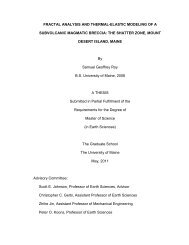Latis II Underwater Remotely Operated Vehicle Technical Report
Latis II Underwater Remotely Operated Vehicle Technical Report
Latis II Underwater Remotely Operated Vehicle Technical Report
Create successful ePaper yourself
Turn your PDF publications into a flip-book with our unique Google optimized e-Paper software.
FUTURE IMPROVEMENTS<br />
Throughout the entire design process the ROV<br />
Team had to continuously change, alter and in<br />
some cases completely remove or disregard<br />
design components and ideas. Some of these<br />
ideas, if they had been followed through, could<br />
have made great designs. The following are<br />
some design ideas the team would like to see<br />
either pursued and integrated or improved<br />
upon.<br />
PROPULSION<br />
Early in the design of the prototype the team<br />
battled with designing the best propulsion<br />
system for the ROV. Ideas ranged from belts<br />
and flippers to hydraulics and pneumatics. One<br />
idea that continuously surfaced, however, is<br />
that of dynamic thrusters. With dynamic<br />
thrusters, the same thrusters from Seabotix<br />
could be used but instead of being statically<br />
mounted to the body of the ROV they would be<br />
mounted to rotatable plates such that they<br />
could turn up to 360deg. This would allow a<br />
single thruster to control at least two axis of<br />
motion instead of just one when statically<br />
mounted. Servos or any kind of motor<br />
electrically driven or otherwise could be used to<br />
rotate the thruster. The team would be able to<br />
literally double their effectiveness with each<br />
thruster and therefore cut the number of<br />
thrusters, and motor drivers in half. The<br />
downside of this is making the device that<br />
would have to turn the thruster and then<br />
integrating the extra control specifications into<br />
the control program.<br />
17<br />
LATIS <strong>II</strong><br />
TECHNICAL REPORT<br />
WATERPROOFING<br />
Being one of the most, if not the most, difficult<br />
problems plaguing the ROV team;<br />
waterproofing techniques and design could be<br />
improved. If the design had taken into account<br />
more water tight compartments and less thruwall<br />
connections the waterproofing would have<br />
been much easier. Furthermore, using less<br />
electronics would also help in this respect (i.e.<br />
hydraulic or pneumatic propulsion/power<br />
system that is already inherently waterproof).<br />
KEEP IT SIMPLE STUPID (KISS)<br />
Even with the team’s best efforts to try and<br />
make the design as simple as possible without<br />
compromising function, the project still proved<br />
to be far too complicated to complete in the<br />
time allotted and with the people and resources<br />
available. The team would like to see future<br />
teams drastically cut down on the complexity of<br />
the manufactured parts and the overall design.<br />
Although many pre-made parts were<br />
researched and considered for the ROV design,<br />
a huge number of components still had to be<br />
custom fabricated. Taking less time and effort<br />
to make custom parts would leave more time to<br />
practice with the ROV and prepare it for<br />
competition.

















